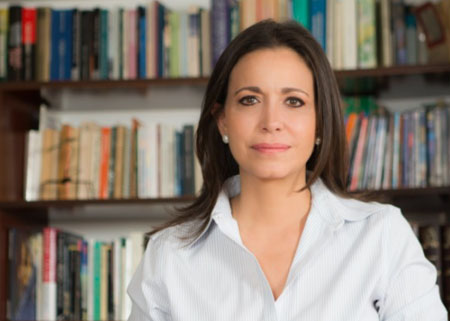by WorldTribune Staff, November 24, 2020
One of the leading opposition voices against the socialist regime in Venezuela has detailed how dictator Hugo Chavez in 2004 put in place a voting system to rig the country’s elections in the socialists’ favor.
In a Nov. 23 interview with ElAmerican.com, Maria Corina Machado, Venezuelan civil rights leader and National Assembly member, described how Chavez used the Smartmatic system, the voting machines startup bought by Dominion Voting Systems.

Machado said of an effort to collect signatures on a recall referendum on Chavez: “On February 2, 2003, in a single day, we exceeded all expectations and collected more than 3 million signatures. Immediately outraged, the regime annulled the whole process through a blatant disregard for the law. They illegally imposed all kinds of additional requirements that made it almost impossible to collect the signatures again, but we did it!”
Machado said that Chavez “was forced to accept the call for the presidential recall referendum. But what Chavez would never allow was to lose that, or any other election. Therefore, at that very moment, a great operation began to prevent Venezuelan society, which was already mostly opposed to his mandate, from expressing itself freely. One of the first things the regime understood was that it had to completely control the electoral system, but never leave any traces of fraud.”
To achieve this, the Chavez regime “needed to change the existing electronic voting platform,” Machado said. “The Venezuelan law required the acquisition of a new electoral technology to be through a bidding process but they found an excuse not to do so: the existence of a ‘new’ technology that offered a ‘paper trail’ (printed ballots of each electronic vote), which would allow the votes to be counted in physical form and supposedly prevent electronic fraud. The newly created company, without any prior electoral experience, which was awarded the contract was Smartmatic.”
Machado said that, once the Smartmatic system was acquired, “in a matter of a few months, the commitment of counting 100% of the ballots was reduced to 30% and, finally, to 1% (equivalent to 196 voting tables), arguing that, statistically, it was a more than sufficient sample.”
Machado continued: “Another element that we denounced from the beginning was the fact that the voting machines printed out the results after an Internet connection was established, which Smartmatic assured was one-way —that is, it only transmitted information from the voting machine to the computer center. Subsequently, the transmission logs of the telecommunications company CANTV were accessed, and it was found that there was bidirectional information transmission before the results were printed.”
Exit polling showed that 56 to 58 percent of voters went against Chavez and his socialist regime.
“However, when the results began to be broadcast that night, the situation was very different. Surprisingly, the numbers changed to exactly the opposite: Chavez had an advantage of more than 15 points, contradicting all the exit polls that had been made during the day,” Machado noted.
The 2004 recall referendum “was a sophisticated fraud,” Machado said. “They carried out diverse practices that altered the results, and when added, layer upon layer, they configured a gigantic fraud. This included the bulging of the electoral register by 21%, incorporating people who were dead and foreigners who did not qualify to vote. Another practice was instilling fear in the population, both through the public campaign and in the presence of regime agents in the voting centers, many of whom were installed next to the Smartmatic machine, eliminating the secrecy of the vote. But unquestionably, the biggest fraud was an electronic platform that generated an electronic fraud, which was conceived to leave no trace; and when a trace existed — that is, the paper ballot — they made sure that it was not audited before destroying it.”
From 2004 to 2017, the Smartmatic system was used in 14 elections in Venezuela. Machado said the fraudulent activity got more sophisticated as the years went on.
“Indeed, if these criminal systems learn anything, it is not to make the same mistake twice,” Machado said. “With each process, they become more sophisticated and more difficult to detect. Soon after, we realized that there was no single reason that explained all the fraud, but that it was a sum of events and mechanisms. Each one brings a component of the fraud, and together, the result is devastating.”
Intelligence Brief __________ Replace The Media
